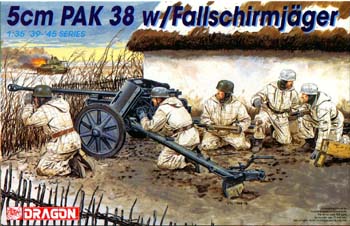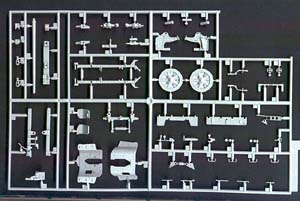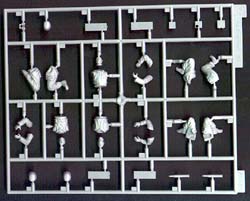


 DML
1/35th 5cm Pak 38 with Fallschimjager figures
DML
1/35th 5cm Pak 38 with Fallschimjager figures
by Ray Mehlberger
MSRP: $20.00
History:
By 1940, it was evident that the 7.5cm anti-tank guns used by the German Army were of very limited value against the armor of enemy tanks then in service. Fortunately, this had been realized as early as 1937 and by 1938 Rheinmetall-Borsig had developed and produced a new anti-tank gun of 50mm (1.97in) caliber. By 1939 the design was ready for production, but it was not until midsummer 1940 that the first examples reached the troops. It was designated the 5cm Pak 38, and was too late to take much part in the current campaigns of that year.
It was not until 1941 that the gun started to see major use, in the invasion of Russia. By that time, the new gun had been supplied with a new type of tungsten-cored ammunition known as AP40. This ammunition was patterned after captured Czech and Polish ammunition and was adopted because tungsten cores offered a considerable increase in armor penetration. This was sorely needed, for when the Soviet T-34/76 appeared on the battlefields the Pak 38, firing AP40, proved to be the only gun/projectile combination capable of penetrating this new Soviet tank's hide. However, the number of Pak 38s on hand were very limited in supply. The gun could not be everywhere at the same time. Conversions of old captured French 75mm (2.95in) guns were hurriedly used to fill the many gaps in the anti-tank defence lines.
After that, the 5cm (1.97in) gun proved good enough to remain in service for the remainder of the war, although it was largely replaced by heavier-caliber weapons later. The Pak 38 was a well-designed gun and with its curved shield, steel wheels, and a tubular split-trail carriage that locked out the torsion bar suspension when the trail legs were spread. Light alloys were used throughout the construction of the carriage, which made the gun easy to handle. There was also a small dolly wheel for manhandling. The long barrel featured a muzzle brake.
 The
Pak 38 was one of the German army's standard anti-tank guns and was also
further developed at one stage to take an automatic feed. This enabled
the gun to be used as a heavy anti-aircraft weapon, and at one point this
ack ack version was fitted to a variant of the Me-262 jet fighter. Later,
this same weapon was further adapted to be used as a ground-mounted anti-aircraft
gun, but that appeared very late in the war and none seem to have been
mass produced. There was also a tank gun version of the Pak 38 that was
manufactured in a number of models, so many in fact that large numbers
ended up as beach defence weapons on the Atlantic Wall.
The
Pak 38 was one of the German army's standard anti-tank guns and was also
further developed at one stage to take an automatic feed. This enabled
the gun to be used as a heavy anti-aircraft weapon, and at one point this
ack ack version was fitted to a variant of the Me-262 jet fighter. Later,
this same weapon was further adapted to be used as a ground-mounted anti-aircraft
gun, but that appeared very late in the war and none seem to have been
mass produced. There was also a tank gun version of the Pak 38 that was
manufactured in a number of models, so many in fact that large numbers
ended up as beach defence weapons on the Atlantic Wall.
The Pak 38 was also mounted on a number of tracked Panzerjager carriages. At one point, so many had been captured by the British army that they were later reconditioned and stockpiled against any future wars or conflicts that may have arose.
What is in the box?
The kit contains one large, medium, and small light gray plastic trees. No decals, and a 8 page gatefold set of instructions.
The largest tree contains all the parts for the Pak 38. There are 55 parts here.
 The
medium sized tree holds three gun crew figures in heavy, quilted, winter
uniforms, their helmets, a pair of binoculars, an ammo case for Pak 38
ammo, and two live 5cm ammo rounds. The figures have separate heads, arms,
torsos, and leg pieces molded from the hips on down. 31 total parts here.
The
medium sized tree holds three gun crew figures in heavy, quilted, winter
uniforms, their helmets, a pair of binoculars, an ammo case for Pak 38
ammo, and two live 5cm ammo rounds. The figures have separate heads, arms,
torsos, and leg pieces molded from the hips on down. 31 total parts here.
The smallest tree contains the parts of the last two figures (also in the heavy, quilted uniforms), two canteens, two bread bags, one bayonet, four ammo pouches, and two helmets. 23 parts in all. Unfortunately, there are NO Luftwaffe decals for the helmets of these figures. There are no decals in the kit at all. Some Kill rings for the gun barrel of the Pak 38 would have been nice.
The first page of the 8 page instruction sheet repeats the box art...in black and white...and pictures of all three parts trees. There is no history of the gun in the kit....and this is one of my pet peeves with DML kits...they expect the modeler to know everything about the kits he buys of their armor products, or to have a vast home library handy to look up data.
Page 2 interprets the various symbols used in the assembly steps, and gives the color code number chart. The bottom of this page gives the first 2 assembly steps for the wheeled carriage of the Pak 38.
 Pages
3 through 5 give the 13 total assembly steps for the total Pak 38 assembly.
Pages
3 through 5 give the 13 total assembly steps for the total Pak 38 assembly.
Pages 6 and 7 show assembly and painting for the 5 figures and the one ammo box provided in the kit.
On the bottom of page 7 is a black and white photo of a diorama that was made with this kit. This same picture appears, in color, along with 2 other photos of the diorama, on the side of the kit box. By the way, Volstad has done a very good box art painting. I sure admire his work.
Page 8 is the marking and painting guide for the Pak 38, along with decaling instructions.
The decal application instructions are silly as there are NO decals in the kit... as mentioned earlier in this review.
Conclusion
I highly recommend this kit to armor modelers that like anti-tank guns or artillery. The only reservations I have about the kit were mentioned earlier....no decals....no history on the instruction sheet. I would have liked to see more ammo rounds for the Pak 38 too. Only 2 loose ones and one ammo case that contained 4 at one time would have this gun crew in big trouble on the Russian front for sure. DML should have given you more of these...really...in the kit. Some side arms for the gun crew would have been welcome too.
I have heard some modelers say that they would have preferred the gun crew to have been Wehrmacht and not Fallschirmjagers... but that does not bother me too much... these figures are well done and nicely animated.

Previous: Contents








